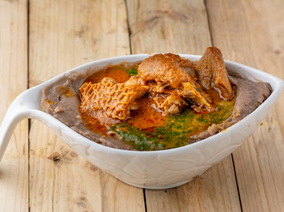
Amala Recipe: Make Easy Lump-Free Nigerian Swallow
Amala is a popular Nigerian dish that is made from yam flour. It is a staple food in many parts of Nigeria and is often served with a variety of soups and stews. The dish is known for its distinctive taste and texture, which is both hearty and satisfying.
To make amala, people mix yam flour with hot water to form a thick, dough-like consistency. The mixture is then kneaded until it is smooth and free of lumps. The resulting dough is then formed into small balls, which are boiled in water until they are cooked through. The finished amala is dense and chewy, with a slightly nutty flavor that is unique to yam flour.

Understanding Amala
Amala is a popular food among the Yoruba tribe in the western part of Nigeria. It is a basic food in Nigerian cuisine and is widely consumed by people in Ibadan and other parts of Africa.
Amala is made from yam flour, which is a flour made from dried yam. The yam flour is mixed with water and cooked on a stove until it forms a thick, smooth, and elastic dough. The dough is then rolled into balls and served with soup or stew.
The Yoruba people have been consuming amala for centuries. It is a traditional food that has been passed down from generation to generation. Today, amala is enjoyed by people of all ages and backgrounds in Nigeria and beyond.
Amala is a nutritious food that is rich in carbohydrates, fiber, and other essential nutrients. It is also low in fat and calories, making it a healthy food option for people who want to maintain a healthy lifestyle.
Types of Amala
There are two main types of amala: black amala and white amala.
Black Amala
Black amala is made from yam flour and is usually dark in color. It is a popular choice among Nigerians and is often served with ewedu soup, gbegiri soup, or okra soup. Black amala is rich in fiber and provides a good source of energy.
White Amala
White amala is made from cassava flour and is usually lighter in color compared to black amala. It is a popular choice among Nigerians and is often served with vegetable soup, egusi soup, or okra soup. White amala is gluten-free and provides a good source of carbohydrates.
When making amala, it is important to use the right type of flour. Cassava flour is used to make white amala, while yam flour is used to make black amala. Unripe plantain flour, also known as elubo ogede, can also be used to make amala.
In conclusion, black amala and white amala are the two main types of amala. They are both popular choices among Nigerians and are usually served with different types of soup or stew. When making amala, it is important to use the right type of flour to achieve the desired texture and taste.
Amala’s foundation lies in its key ingredient – amala flour. Derived from yam, plantains, or cassava, this flour undergoes a meticulous process of drying, grinding, and sieving to achieve its fine texture. The choice of flour contributes to the distinct taste and color of the dish.
Health Benefits of Amala food
Apart from its delicious taste, Amala also offers several health benefits.
Rich in Dietary Fiber
Amala is rich in dietary fiber, which plays a crucial role in maintaining digestive health. Fiber helps to regulate bowel movements, prevent constipation, and reduce the risk of colon cancer. It also helps to keep you feeling full for longer periods, which can aid in weight management.
Lowers Cholesterol Levels
Studies have shown that consuming Amala can help to lower cholesterol levels. This is because the high fiber content in Amala binds to cholesterol and prevents it from being absorbed into the bloodstream. This can help to reduce the risk of heart disease and stroke.
Rich in Vitamins and Minerals
Amala is also rich in vitamins and minerals, including iron, calcium, and potassium. Iron is essential for the production of red blood cells, while calcium is necessary for strong bones and teeth. Potassium helps to regulate blood pressure and maintain fluid balance in the body.
Gluten-Free
Amala is gluten-free, making it an excellent choice for people with celiac disease or gluten intolerance. It is also a good alternative to wheat-based products for those who are looking to reduce their gluten intake.
Conclusion
In summary, Amala is a delicious and nutritious dish that offers several health benefits. It is rich in dietary fiber, vitamins, and minerals, and can help to lower cholesterol levels and regulate bowel movements. Adding Amala to your diet can be a great way to improve your overall health and wellbeing.
Ingredients for Amala
To make a delicious Amala, the following ingredients are required:
- 2 cups of yam flour (sifted)
- Hot water
- Medium-sized pan
- Large quantity
Yam flour is the primary ingredient needed to make Amala. It is a fine powder made from yam tubers that have been peeled, sliced, and dried. The yam flour must be sifted to remove any lumps and ensure a smooth consistency.
Hot water is required to mix with the yam flour to form a dough. The water should be boiled and kept hot throughout the preparation process.
A medium size pan is needed to cook the Amala. The pan should be deep enough to allow for the dough to be stirred without spilling over.
A large quantity of Amala can be made by adjusting the ingredients’ ratios to suit the number of people being served. It is important to note that the more yam flour used, the thicker the Amala will be.
Overall, these ingredients are essential to making a perfect Amala. With the right measurements and preparation, anyone can enjoy this delicious Nigerian dish.
The Drying Process: Turning Ingredients into Flour
Before Amala takes its final form, the ingredients undergo a meticulous drying process. Yam, plantains, or cassava are peeled, sliced, and sun-dried until they lose most of their moisture. Once dried, these slices are ground into fine powder, which forms the foundation of Amala flour.
Simple steps to Making Amala
Preparation
To make a delicious amala, the first step is to gather all the necessary ingredients. These include yam flour, water, and a pinch of salt.
- Use a standard measuring cup to ensure that the right amount of flour and water is used.
- Place a pot on medium heat and add water to it.
- While the water heats up, place the yam flour in a separate bowl.
- Once the water is hot, gradually add the yam flour to the pot using a wooden spoon.
Cooking
As the yam flour is added, the wooden spoon should be used to stir the mixture continuously. This will help to prevent lumps from forming and ensure that the amala is smooth. The mixture should be cooked for about 10-15 minutes or until it becomes thick and stretchy.
Once the amala is cooked, it should be turned onto a clean surface and kneaded until it becomes smooth and elastic. This can be done by using the hands or a wooden spoon. The amala can then be divided into smaller balls and served with a variety of soups and stews.
In summary, making amala is a simple process that can be done by following a few easy steps. By using a standard measuring cup, a wooden spoon, and following this step-by-step guide, anyone can make delicious amala in no time.
Serving Suggestions
Amala is a versatile dish that can be paired with a variety of soups and stews. Here are some serving suggestions to help you enjoy your amala to the fullest:
Ewedu Soup
Ewedu soup is a popular accompaniment to amala in Nigeria. This soup is made from jute leaves and is often served with a rich, spicy stew. To enjoy your amala with ewedu soup, simply scoop a portion of amala onto your plate and pour the soup over it. Use a spoon to mix the two together, and enjoy!
Soup of Your Choice
If you prefer a different soup, amala can be paired with almost any type of soup or stew. Some popular options include egusi soup, ogbono soup, and vegetable soup. Simply prepare your soup of choice and serve it alongside your amala. Use a spoon to mix the two together, and enjoy!
Popular Nigerian Soups
Amala is a staple food in Nigeria, and there are several soups that are commonly served with it. Some of the most popular Nigerian soups include:
- Egusi Soup: made from ground melon seeds and often served with leafy greens and meat or fish.
- Ogbono Soup: made from ground ogbono seeds and often served with leafy greens and meat or fish.
- Vegetable Soup: made from a variety of vegetables and often served with meat or fish.
To enjoy your amala with any of these soups, simply scoop a portion of amala onto your plate and pour the soup over it. Use a spoon to mix the two together, and enjoy!
No matter which soup you choose to pair with your amala, be sure to serve it hot and fresh for the best taste and texture.
Ibadan People and Their Love for Amala
Amala holds a special place in the heart of Ibadan, a city in southwestern Nigeria. It’s not just a dish but a cultural emblem that binds the community. People of all ages enjoy Amala, from bustling restaurants to humble homes. It transcends social barriers.
The Art of Amala: Exploring Different way
Different techniques are used to prepare Amala, each offering a unique twist to the dish.
1. Traditional Wooden Stirring: Many consider the traditional method of stirring Amala with a wooden spatula essential for its authenticity. The rhythmic motion of stirring plays a role in achieving the desired texture.
2. Electric Mixer Method: In modern kitchens, some opt for using an electric mixer for convenience. This method ensures a smoother texture, though some argue that it may lack the traditional touch.
3. Flour Combination: Amala lovers often experiment with combining different types of flour, such as yam and plantain, to create their signature blend. This adds a personal touch to the dish and allows for customization.
Amala isn’t just a meal; it’s an embodiment of Nigerian food culture. It brings people together, ignites conversations, and carries the legacy of generations. From local eateries to elaborate feasts, Amala has made its mark on the culinary landscape.
One of the intriguing aspects of Amala is the “lump” phenomenon. Many Amala lovers take pride in their ability to create a perfectly amala- lump free dish. Achieving this takes practice, patience, and the right technique.
Storing and Reheating
After preparing amala, you can store it in an airtight container in the refrigerator for up to 3 days. You can also freeze it for up to 1 month. When freezing, it is recommended to divide it into portions for easier reheating.
To reheat the amala, it is best to use a microwave or a steamer. If using a microwave, sprinkle some water on the amala and cover it with a damp paper towel to prevent it from drying out. Microwave for 1-2 minutes, stirring occasionally, until heated through.
If using a steamer, wrap the amala in a damp cloth and steam for 5-10 minutes until heated through. Alternatively, it can be reheated in a pot with some water over low heat, stirring occasionally.
It is important to note that reheated amala may not have the same texture as freshly made amala. It may become slightly harder and less fluffy. However, it will still be delicious and nutritious.
When reheating leftover amala, it is recommended to add a small amount of water to the pot or steamer to prevent it from sticking to the bottom. It is also important to check the consistency of the amala and add more water if necessary.
Next time you prepare amala, consider making a larger batch and storing it for later use. This will save time and effort in the kitchen and ensure that you always have a healthy and tasty meal on hand.
Alternative Amala Recipe
While yam, cassava, and plantain are the primary sources of amala flour, each type contributes to a unique flavor profile. Yam-based amala flour tends to have a mild, earthy taste, while cassava-based flour offers a nutty undertone. Plantain-based amala flour boasts a slightly sweet essence, adding complexity to the dish. For those looking to switch things up from the traditional yam flour-based amala, there are several alternative options to consider. Here are a few alternative amala recipe to try out:
Unripe Plantain Amala
Unripe plantains are a great alternative to yam flour for making amala. To make unripe plantain amala, peel and slice the unripe plantains into small pieces and dry them in the sun or a dehydrator. Once dry, grind the plantain pieces into a fine powder. To prepare the amala, mix the plantain powder with boiling water and stir until it forms a smooth consistency. Serve with your favorite soup or stew.
Cassava Amala
Cassava, also known as yucca or manioc, is a starchy root vegetable that can be used to make a delicious amala. To make cassava amala, peel and slice the cassava into small pieces and boil until soft. Once cooked, mash the cassava into a smooth paste and form into balls. To serve, place the cassava balls in a bowl and pour hot water over them. Allow the cassava to soak up the water and become soft before mixing and eating with your favorite soup or stew.
Millet Amala
Millet is a gluten-free grain that can be used to make a nutritious amala. To make millet amala, grind the millet into a fine powder and mix with boiling water until it forms a smooth consistency. Serve with your favorite soup or stew.
Brown Rice Amala
Brown rice is another great alternative to yam flour for making amala. To make brown rice amala, grind the brown rice into a fine powder and mix with boiling water until it forms a smooth consistency. Serve with your favorite soup or stew.
Overall, there are several alternative amala recipe to try out. Whether you’re looking to switch things up or have dietary restrictions, these recipes offer delicious and nutritious options.
Conclusion
In conclusion, making Amala is a straightforward process that requires only a few ingredients. The recipe is easy to follow, and the result is a delicious and nutritious meal that is enjoyed by many people in Nigeria and beyond.
Amala is a great source of energy, fiber, and essential nutrients like iron, calcium, and potassium. It is also gluten-free, making it an excellent choice for people with celiac disease or gluten intolerance.
When making Amala, it is important to use high-quality yam flour and to follow the recipe precisely. Adding too much water or not kneading the dough enough can result in a lumpy and unappetizing dish.
To enhance the flavor of Amala, it can be served with a variety of soups and stews, such as Egusi soup, Okra soup, or Ewedu soup. It can also be enjoyed with vegetable sauce, fish sauce, or any other sauce of your choice.
Overall, Amala is a nutritious and delicious meal that is easy to make and can be enjoyed by people of all ages. With the right ingredients and recipe, anyone can prepare this dish and enjoy a taste of Nigeria.
Egusi Soup Recipe: How to Make the Best Nigerian Soup





